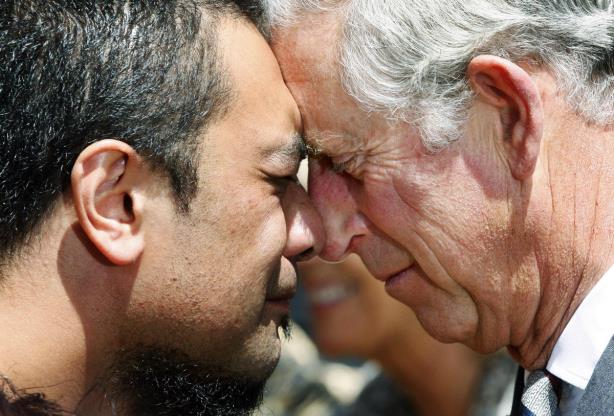New Zealand is a country of which the heritage is shared by the members of two different cultures. On the one hand, the Māori, the indigenous people of New Zealand, on the other hand the Pākehā, the people of European descent.
In the beginning one could say the heritage was not shared by these two peoples at all, the Māori were the only people that successfully resisted violent colonisation by the British crown through their strong military power to avoid a life as ‘second class citizens’. So, a formal agreement was made, and February 6, 1840 the Māori chiefs and the representatives of the British Crown signed the Treaty of Waitangi, which was a formal agreement making New Zealand a British colony that was supposed to have equal rights.
Consequently, the government presented the treaty as the founding document of New Zealand. Even though the Māori have achieved this supposedly equal agreement, they are often still outsiders of society systematically driven to drug addiction.
But, New Zealand’s Māori Heritage and Culture has impact on the daily life, the extent of it varying from region to region. The most intense being in the North Island where about 86% of all people identify themselves as Māori. Understanding Māori culture is often among the performance objectives and outcomes of one’s job description (New Zealand Immigration, 2016).
The linguistic Heritage of New Zealand, Te Reo, the language of the Māori has as gained strength in the last years. This is forwarded by an increase in the number of Māori words and phrases, an achievement made possible through the bicultural use of the language as it is being spoken by both Māori and Non- Māori.
In addition to that, the New Zealand Ministry for Culture and Heritage published a collection of Māori words and phrases commonly used as well as an audio guide to facilitate the acquisition of the language. Meeting places of the Māori (the Marae) also welcome Pākehā New Zealanders.
The use of two names for one place is frequent as many of these places have a name in each of the two languages English and Te Reo. the Te Taura Whiri I te reo Māori (The Māori language commission) have created an interactive map demonstrating their accurate Māori pronounciation.
On the other hand, previous generations perceived the Māori culture was rather avoided than celebrated, possibilities to learn about the Māori culture and language were very limited.
Furthermore, biculturalism in this case does not concern a
“substantial redistribution of power and resources in favour of Maori that a more substantive relationship should imply” (Bennett and Liu, 2017: p. 3)
Another aspect that is very susceptible to criticism is the fact that the Māori were forced to live within a system (politic, legal, etc.) that isn’t theirs through colonisation. Some claim the biculturalism should go even further through the establishment of separate Māori institutions such as for example a Māori House of representatives in the New Zealand Parliament.
Another Issue in New Zealand is the shocking proportion of Māori in New Zealand’s prisons. About 50% of prison inmates identify themselves as Māori, which is extremely disproportionate.
One issue with which this shocking phenomenon can be explained is that many of the prison inmates have a distorted perspective of the Māori values and culture and therefore often feel as if they were justified in their action by their culture. Bands connected to organised criminality often use Māori tattoos as a sign of their Māori ancestry and by that as a legitimisation of their crimes, a sign of their misconception of the Māori culture (Manhire, 2015).
After having discussed all those issues and achievements we can say that there have been great achievements but that there are still issues in present-day New Zealand that solutions need to be found for, that should be eliminated or at least addressed. New Zealand needs to embrace its bicultural Heritage and make it a bigger part of their education to avoid misconceptions and discrimination and wrong actions based on them.
Dohwuheritage – D.O.
References:
Allan, B. and Smylie, J. (2015). First Peoples, Second Class Treatment: The role of racism in the health and well-being of indigenous peoples in Canada. Toronto, ON: the Wellesley Institute. (p. 4)
Bennet, S. T. and Liu, J.H. (2017). Historical trajectories for reclaiming an indigenous identity in mental health interventions for Aotearoa/New Zealand—Māori values, biculturalism, and multiculturalism. International Journal of Intercultural Relations. In press, corrected proof, Available online 1 July 2017; Available at: https://doi.org/10.1016/j.ijintrel.2017.05.005 [Accessed 21.11.2017].
Cook, M. (2013). ‚Māori smoking, alcohol and drugs – tupeka, waipiro me te tarukino‘. In: Te Ara – the Encyclopedia of New Zealand. Available at: https://teara.govt.nz/en/maori-smoking-alcohol-and-drugs-tupeka-waipiro-me-te-tarukino [Accessed 23.11.2017].
Hayward, J. (2012). ‘Biculturalism’. In: Te Ara – the Encyclopedia of New Zealand. Available at: https://teara.govt.nz/en/biculturalism?utm_source=newzealandnow.govt.nz [Accessed 21.11.2017].
Johnstone, I. (1984). The Beginner’s Guide to Visiting the Marae. [Video] Available at: https://www.nzonscreen.com/title/the-beginners-guide-to-visiting-the-marae-1984/overview [Accessed 21.11.2017].
Lawrence, Nora. (2010). Working Towards Maori Equality. Cultural Survival Quarterly Magazine, [online]. Available at: https://www.culturalsurvival.org/publications/cultural-survival-quarterly/working-towards-maori-equality [Accessed 21.11.2017].
Lovell-Smith, M. (2007). ‚Early mapping – Māori and maps of colonisation‘ In: Te Ara – the Encyclopedia of New Zealand. Available at: https://teara.govt.nz/en/early-mapping/page-6 [Accessed 23.11.2017].
McAloon, J. (2008) ‘Land ownership – Māori and land ownership’, In: Te Ara – the Encyclopedia of New Zealand. Available at: http://www.TeAra.govt.nz/en/land-ownership/page-1 [Accessed 23.11.2017].
Manhire, T. (2015). Unlocking Maori identity: keeping New Zealand’s indigenous people out of jail. Theguardian, [online]. Available at: https://www.theguardian.com/world/2015/aug/15/regaining-maori-identity-and-keeping-them-out-of-new-zealands-jails [Accessed 21.11.2017].
Newzealand.com, (n.d.). Treaty of Waitangi. [online] Available at: https://www.newzealand.com/nieuw-zeeland/feature/treaty-of-waitangi/?cid=p:sem:UK:FY18:Pure:Google:UK_G_S_DSA_Travel_to_NZ_Northland:txt:&kwi [Accessed 21.11.2017].
Newzealandnow.govt.nz (2016). Māori culture. [online] Available at: https://www.newzealandnow.govt.nz/living-in-nz/settling-in/maori-culture [Accessed 21.11.2017].
Speak Maori. (2007). Karakia Mo Te Kai – Grace. Available at: https://www.youtube.com/watch?v=3uTBUMy9RZY [Accessed 21.11.2017].
Spoonley, P. (2011). ‘Ethnic and religious intolerance’
In: Te Ara – the Encyclopedia of New Zealand. Available at: https://teara.govt.nz/en/ethnic-and-religious-intolerance/page-1 [Accessed 21.11.2017].
Grace, M. (2014). Weaving Together Maori and Pakeha. [image] Available at:
http://www.nzcms.org.nz/wp-content/uploads/hongiRSZ. jpg
[Accessed 21.11.2017].
